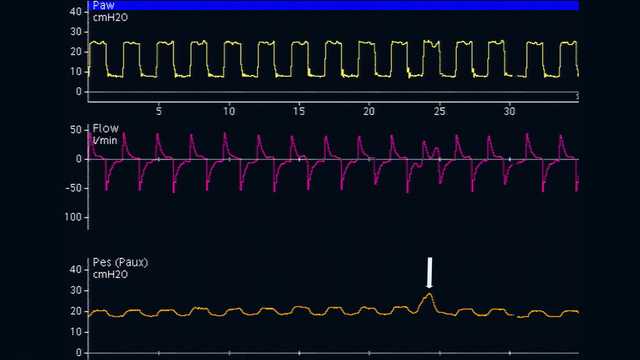
Autor: Jean-Michel Arnal, Senior Intensivist, Hopital Sainte Musse, Toulon, Frankreich
Datum: 19.10.2018
Last change: 09.09.2020
FormattingEine neue physiologische Studie zeigt auf, dass für den ösophagealen Druck der Pleuradruck in der Mitte des Brustkorbs bei allen PEEP-Werten geschätzt wird. Eine absolute Messung des ösophagealen Drucks ist für die Einstellung von PEEP und die Überwachung des transpulmonalen Drucks somit hilfreich.

Wie wird also der ösophageale Druck korrekt gemessen?
Der ösophageale Ballon muss korrekt positioniert und aufgeblasen werden. Dann muss seine Platzierung überprüft werden.
Die optimale Platzierung für den ösophagealen Ballon ist im unteren Drittel der Speiseröhre in einem Abstand von 35 – 45 cm zu den Nasenlöchern. Der Patient wird in eine halbliegende Position gebracht und der leere Ballon wird zuerst in den Magen eingeführt, der sich ungefähr 50 – 60 cm unterhalb der Nasenlöcher befindet. Dann wird der Ballon auf das Standardvolumen aufgeblasen (1 ml bei einem Katheter von Cooper Surgical und 4 ml bei einem Katheter von Nutrivent). Der Magendruck weist eine positive Abweichung während der Inspiration bei passiven wie bei spontan atmenden Patienten auf. Die Positionierung im Magen wird überprüft, indem auf den Magen vorsichtig manueller Druck ausgeübt wird, was sich in einem sofortigen Anstieg des Magendrucks widerspiegelt (siehe Abbildung 1).

Anschliessend wird bei aufgeblasenem Ballon der Ösophaguskatheter vorsichtig zurückgezogen, sodass der Ballon im unteren Drittel der Speiseröhre platziert wird. Während des Wechsels von Magendruck (siehe Abbildung 2) zu ösophagealem Druck (siehe Abbildung 3) verändert sich die Basisdruckkurve und kardiale Oszillationen werden angezeigt.
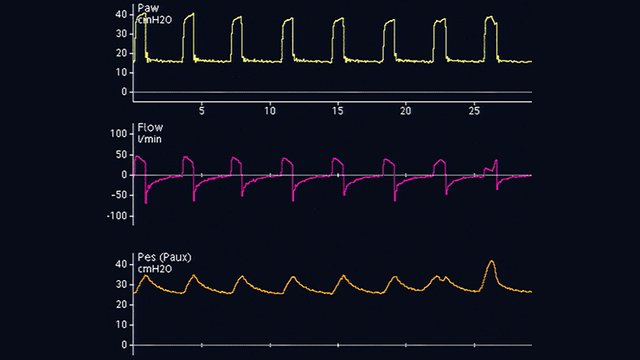
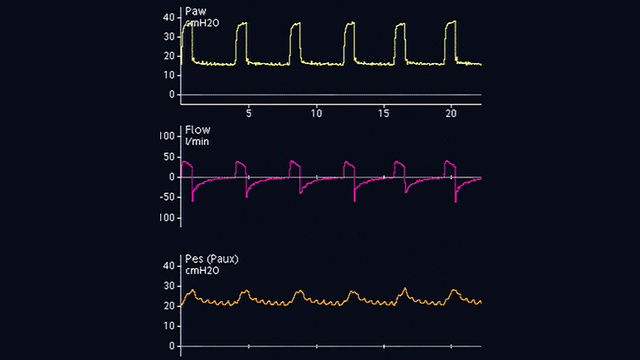
Die Auslenkungen im ösophagealen Druck sind während der Inspiration bei passiven Patienten positiv (siehe Abbildung 4), bei spontan atmenden Patienten jedoch negativ (siehe Abbildung 5). Wenn die kardialen Oszillationen das Signal für den ösophagealen Druck verzerren, kann der Katheter noch weitere 2 – 5 cm herausgezogen werden.
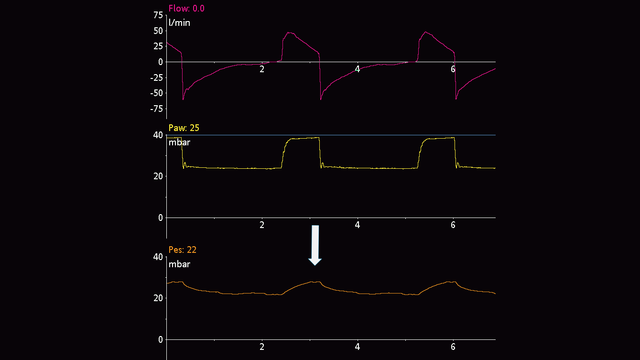
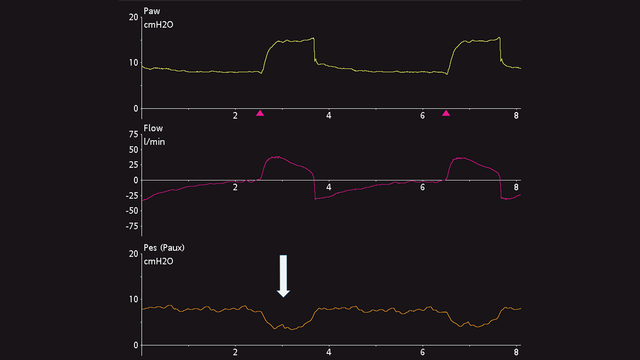
Das Luftvolumen für ein angemessenes Aufblasen des Ballons sollte individuell titriert werden. Dies ist nur bei passiven Patienten möglich. Gemäss der von Mojoli et al (2016) vorgeschlagenen Methode wird der Ballon bei Verwendung eines Katheters von Cooper Surgical schrittweise von 0,5 bis 3 ml aufgeblasen, und bei Einsatz eines Katheters von Nutrivent in 1-ml-Schritten von 1 bis 8 ml (siehe Abbildung 6). Während des progressiven Aufblasens des Ballons steigt der ösophageale Basisdruck an und die Stärke der Auslenkungen im ösophagealen Druck verändert sich. Als angemessenes Aufblasvolumen gilt jenes, das der stärksten Auslenkung im ösophagealen Druck entspricht. Zeigen zwei unterschiedliche Aufblasvolumina dieselbe Stärke bei der Auslenkung des ösophagealen Drucks an, wird das niedrigere Aufblasvolumen gewählt.
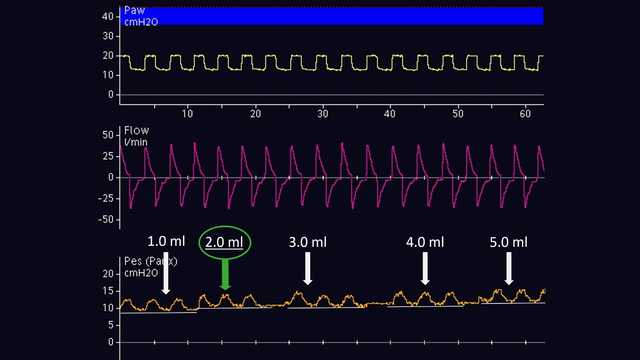
Nachdem der Ballon korrekt in der Speiseröhre platziert und aufgeblasen wurde, wird seine Position mit einem Okklusionstest überprüft. Dazu werden im Prinzip die Atemwege am Ende der Exspiration verschlossen, um dann den Atemwegsdruck zu verändern und zu prüfen, ob sich der ösophageale Druck im selben Ausmass ändert.
Bei passiven Patienten kann eine endexspiratorische Okklusion durchgeführt werden. Führen Sie bei geschlossenem Exspirationsventil manuell eine externe Kompression des Brustkorbs auf beiden Seiten der Brust aus, um eine positive Auslenkung des Atemwegs- und ösophagealen Drucks zu erzeugen. Der Anstieg im Atemwegsdruck und im ösophagealen Druck sollte gleich hoch sein. Anders ausgedrückt: der transpulmonale Druck sollte sich nicht ändern (siehe Abbildung 7).
Bei aktiven Patienten verwendet der dynamische Okklusionstest ebenso eine endexspiratorische Okklusion. Hier ist es nicht nötig, auf den Brustkorb externen Druck auszuüben, da der Patient während der Okklusion eine spontane inspiratorische Bemühung unternehmen wird. Das Ergebnis ist eine negative Auslenkung im Atemwegs- und ösophagealen Druck. Das Abfallen des Atemwegsdrucks und des ösophagealen Drucks sollte gleich stark ausgeprägt sein. Der transpulmonale Druck sollte sich also nicht ändern (siehe Abbildung 8).
Wenn der ösophageale Druck kontinuierlich gemessen werden soll, ist es wichtig, die korrekte Position und das Aufblasvolumen erneut zu überprüfen.
Den vollständigen Quellenverweis finden Sie unten: (
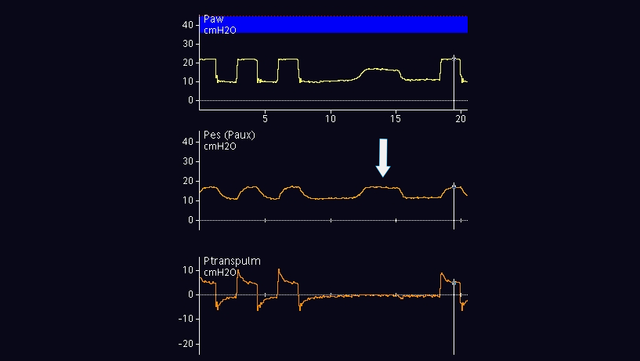
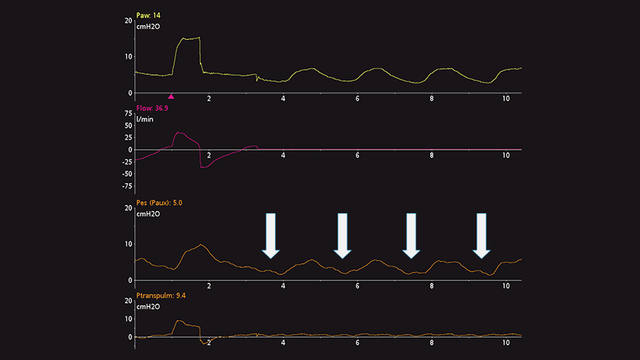
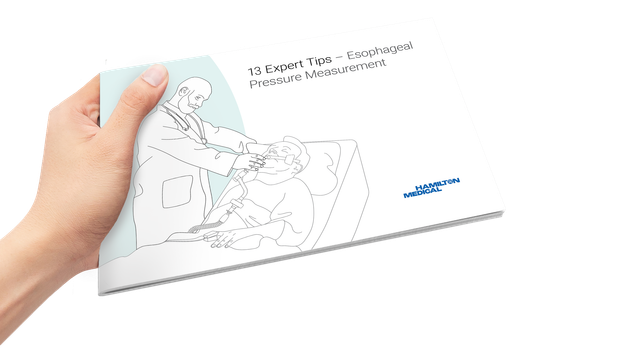
Bewährte Empfehlungen aus der klinischen Praxis, wie Sie bei der Verwendung des ösophagealen Drucks bei ARDS-Patienten vorgehen und was Sie vermeiden sollten.